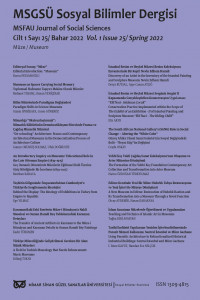Kentleşmenin Kökeni Mezopotamya’da İlk Kentler
MÖ 4. binyılın sonlarında Güney Mezopotamya’da ilk kentler ortaya çıkmaya başlamıştır. Aralarında destanlara konu olan Uruk’un da bulunduğu bu kentlerin, büyük bir nüfus, merkezi bir yönetim, belirgin bir toplumsal sınıflaşma ve anıtsal yapılar ile yazı ve silindir mühür benzeri ekonomiye yönelik denetim yöntemleri gibi ortak özellikleri bulunmaktadır. Bu çalışmada, ilerleyen yüzlerce yıl boyunca geniş coğrafyalara yayılacak olan Güney Mezopotamya kentleşme modelinin temelleri incelenmekte, kentleşmenin önünü açan ve gelişmesini sağlayan toplumsal, çevresel, ekonomik ve ideolojik özellikler tartışılmaktadır.
Anahtar Kelimeler:
Mezopotamya, Kentleşme, MÖ 4. binyıl.
___
- Adams, R. McC. ve Nissen, H. J. (1972). The Uruk Countryside. The Natural Setting of Urban Societies. Chicago ve London: The University of Chicago Press.
- Akkermans, P. M. M. G. ve Schwartz, G. M. (2003). The Archaeology of Syria. From Complex Hunter-Gatherers to Early Urban Societies (ca. 16,000 – 300 BC). Cambridge: Cambridge University Press.
- Aruz, J. (Ed.) (2003). Art of the First Cities. The Third Millennium B.C. from the Mediterranean to the Indus. New York, New Haven ve London: The Metropolitan Museum of Art and Yale University Press.
- Aydın, N. (2017). Hammurabi Yasaları. İstanbul: Alfa Yayınları.
- Childe, G. (1950). The Urban Revolution. The Town Planning Review, 21(1), ss. 3–17.
- Emberling, G. (2002). Political control in an early state: The Eye Temple and the Uruk expansion in northern Mesopotamia. L. Al-Gailani Werr, J. Curtis, H. Martin, A. McMahon, J. Oates ve J. Reade (ed.), Of Pots and Plans (ss. 82–90). London: Nabu Publications.
- Frangipane, M. (2012). Fourth Millennium Arslantepe: The Development of a Centralised Society without Urbanisation. Origini, XXXIV, ss. 19–40.
- Frangipane, M. (2016). The development of centralised societies in Greater Mesopotamia and the foundation of economic inequality. H. Meller, H. P. Hahn, R. Risch and R. Jung (ed.), Arm und Reich – Zur Ressourcenverteilung in prähistorischen Gesellschaften / Rich and Poor – Competing for resources in prehistoric societies. 8. Mitteldeutscher Archäologentag vom 22. Bis 24. Oktober 2015 in Halle (Saale). Tagungen des Landesmuseums für Vorgeschichte Halle 14 (ss. 1–22). Halle: Landesamt für Denkmalpflege und Archäologie Sachsen-Anhalt.
- Frangipane, M. (2018). Different Trajectories in State Formation in Greater Mesopotamia: A View from Arslantepe (Turkey). Journal of Archaeological Research, 26 (1), ss. 3–63.
- Frankfort, H. (1956). The Birth of Civilization in the Near East. Garden City, NY: Doubleday.
- Gates, Ch. (2011). Ancient Cities. The Archaeology of Urban Life in the Ancient Near East and Egypt, Greece, and Rome (2. Baskı). London and New York: Routledge.
- Hansen, D. P. (2003). Art of the Akkadian Dynasty. J. Aruz (ed.), Art of the First Cities. The Third Millennium B.C. from the Mediterranean to the Indus (ss. 189–233). New York, New Haven and London: The Metropolitan Museum of Art and Yale University Press.
- Hrouda, B. (ed.) (2003). Der Alte Orient. Verlorene Schätze, vergangene Kulturen zwischen Euphrat und Tigris. München: Bertelsmann.
- Lambert, W.G., Millard, A.R., Civil, M. (Ed.) (1999). Atra-Hasis. The Babylonian Story of the Flood. Oxford: Clarendon Press.
- Maul, S. (2005). Das Gilgamesch-Epos. Neu Übersetzt und Kommentiert. München: Beck.
- Van de Mieroop, M. (2000). Sargon of Agade and his Successors in Anatolia. SMEA, 42 (1), ss. 239 – 253.
- Mumford, L. (1961). The City in History. Its Origins, Its Transformations, and Its Prospects. San Diego, New York and London: Harcourt.
- Naiboğlu, N. (2018). Anadolu Kent Modelinin Yayılımı. İstanbul: Arkeoloji ve Sanat Yayınları.
- Nissen, H. J. (2003). Uruk and the Formation of the City. J. Aruz (ed.), Art of the First Cities. The Third Millennium B.C. from the Mediterranean to the Indus (ss. 11–20). New York, New Haven ve London: The Metropolitan Museum of Art and Yale University Press.
- Nissen, H. J. (2004). Ana Hatlarıyla Mezopotamya. Yakın Doğu Arkeolojisi’nin İlk Dönemleri (Çev. Z. Z. İlkgelen). İstanbul: Arkeoloji ve Sanat Yayınları.
- Özgüç, T. (1986). New observations on the relationship of Kültepe with south-east Anatolia and North Syria during the third millennium B. C. J. V. Canby, E. Porada, B.S. Ridway ve T. Stech (ed.), Ancient Anatolia: Aspects of change and cultural development. Essays in honor of Machteld J. Mellink (ss. 31–47). Madison: University of Wisconsin Press.
- Reade, J. (2003). The Royal Tombs of Ur. J. Aruz (ed.), Art of the First Cities. The Third Millennium B.C. from the Mediterranean to the Indus (ss. 93–132). New York, New Haven and London: The Metropolitan Museum of Art ve Yale University Press.
- Renger, J. (2003). Wirtschaft und Gesellschaft. B. Hrouda (ed.), Der Alte Orient. Verlorene Schätze, vergangene Kulturen zwischen Euphrat und Tigris (ss. 187–215). München: Bertelsmann.
- Rothman, M. (2002). Tepe Gawra: The Evolution of a Small Prehistoric Center in Northern Iraq, Monograph 112. Philadelphia: University of Pennsylvania Museum.
- Sherratt, A. (1997). Troy, Maikop, Altyn Depe: Early Bronze Age Urbanism and its Periphery (1991). A. Sherratt (ed.), Economy and Society in Prehistoric Europe: Changing Perspectives (ss. 457–470). New Jersey ve Edinburgh: Princeton University Press and Edinburgh University Press.
- Sherratt, A. (2011). Global Development. T. C. Wilkinson, S. Sherratt ve J. Bennet (ed.), Interweaving Worlds. Systemic Interactions in Eurasia, 7th to 1st Millenia BC. Papers from a conference in memory of Professor Andrew Sherratt. What Would a Bronze Age World System Look Like? World Systems Approaches to Europe and Western Asia 4th to 1st Millenia BC (ss. 4–6), Oxford ve Oakville: Oxbow Books.
- Woolley, L. ve Mallowan, M. E. (1976). Ur Excavations, Vol. VII. The Old Babylonian Period. London: British Museum Publications.
- Zettler, R. L. ve Horne, L. (1998). Treasures from the royal tombs of Ur. Philadelphia: University of Pennsylvania, Museum of Archaeology and Anthropology.
- ISSN: 1309-4815
- Yayın Aralığı: Yılda 2 Sayı
- Başlangıç: 2010
- Yayıncı: Mimar Sinan Güzel Sanatlar Üniversitesi
